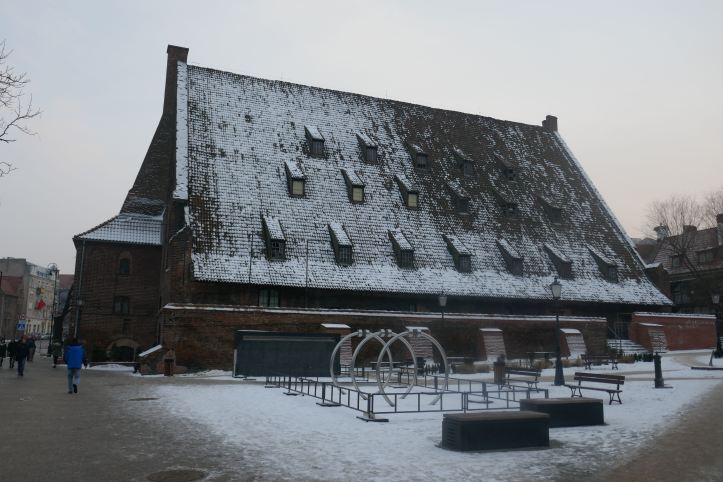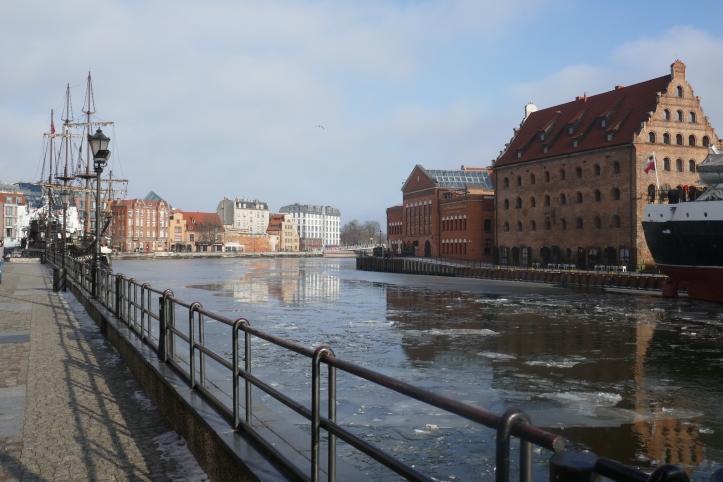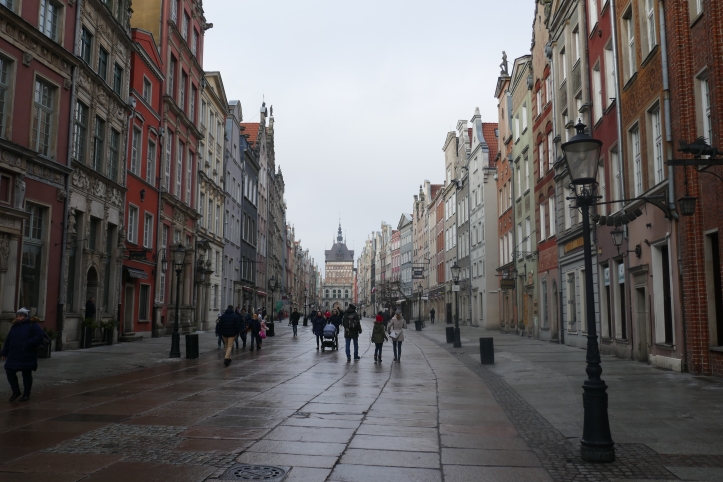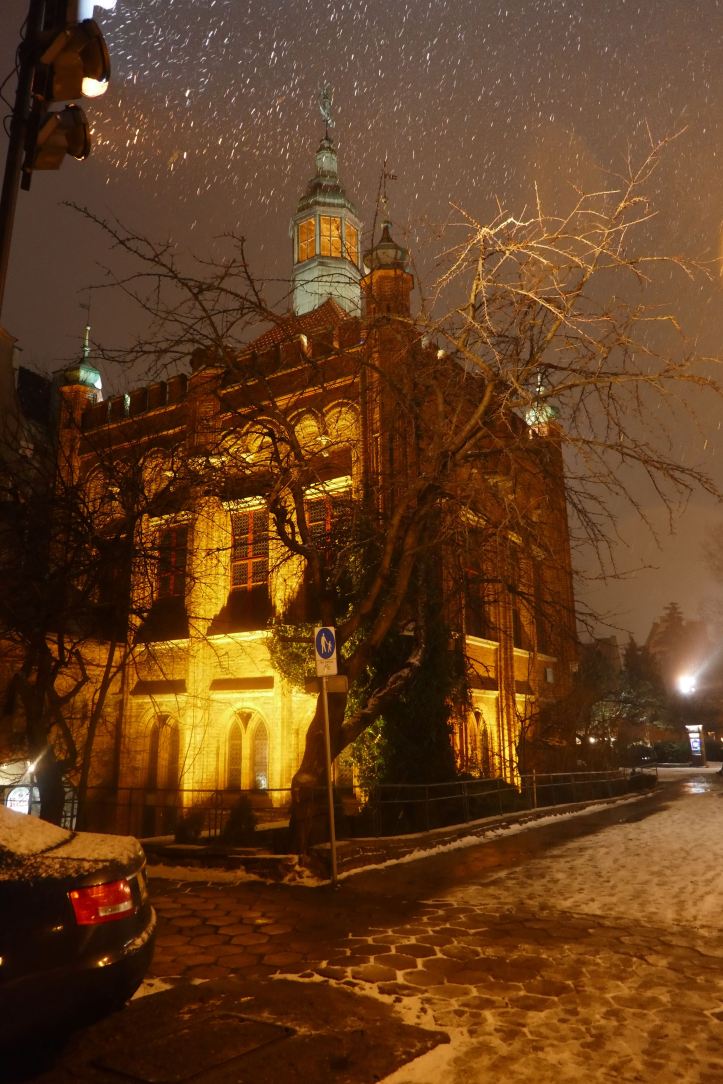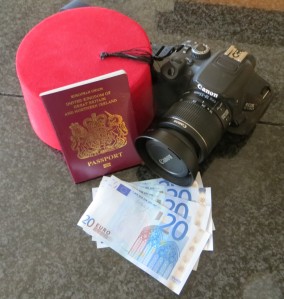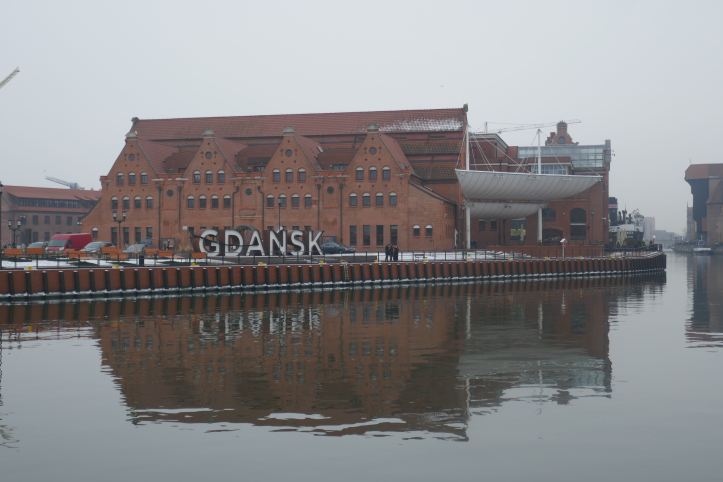Day One – Tuesday
It’s late January 2019 and Gdansk is a city in mourning. It’s only been a fortnight since the city’s Mayor, 53 year old Pawel Adamowicz, was assassinated at the Great Orchestra of Christmas charity event, held annually to raise money to support national health care.
Throughout the city there is evidence of the Mayor’s popularity. Small shrines, candles, photographs, messages, flags at half-mast, video news reports – all testament to a man who was re-elected as Mayor back in 2002 by over 70% of the electorate. In 1998, he was the head of the Gdansk Strike Committee and in 2014 was presented with the Cross of Freedom and Solidarity in recognition of his work on behalf of Polish democracy.
Two weeks after his death, and there continues to be a steady line of mourners at the city’s Basilica of St. Mary of the Assumption where his ashes have been laid to rest.

Obviously, we’d booked to go to Gdansk long before the current situation occurred. In a way, there was something of a political pilgrimage about it as I recall very clearly the UK news footage of Lech Wałęsa’s struggle in the 1980s and the support Solidarność received at the time and which continues still.
Another truth would be that Poland is such a beautiful country and is ideal for a short break. Although Gdansk suffered massive damage during the Second World War, the decision to rebuild it in its pre-war style means that today, the city centre is one of the prettiest you’re likely to find anywhere in Europe.
Until 1939, the Free City of Danzig took in the city of Gdansk as well as over 200 nearby towns and villages. 98% of the population were German and only 1% were Poles. Today, Gdansk, with a total population of over a million, includes the nearby towns of Oliwa, Gydnia and Sopot, all easily accessible by public transport. It was the birthplace of, amongst others, the physicist, Daniel Farenheit, the writer, Gunter Grasse and the politician, Donald Tusk. Oh, and we mustn’t forget Aneta Beata Kręglicka, who was Miss World back in 1989.
Coming to Poland at a time when the relationship between the UK and Europe is in turmoil is interesting. At the airport in Manchester, I chat with a father and daughter who are heading home for a short break. He is 91 and a bear of a man. If we are supposed to shrink as we get older, then, in his prime, he must have been enormous. His daughter who is looking after him, carries a British passport and is a complete Anglophile. We talk about Brexit, of course. She can’t understand why so many voted to leave the EU and wonders for the future. But, what she really wants to talk about is her love for the Royal Family. Who is our favourite Royal? We talk about ‘The Crown’ which she hasn’t seen as she can’t access Netflix. She tells me that she adores Prince Charles and always thought ‘that Diana slept around…but nobody would believe me. I even told my neighbour who has been British all her life‘ (an interesting thought). She thinks that Camilla has had a ‘good effect‘ on Charles. Sometimes, I’m not sure we appreciate how many people from other countries are envious of our Monarchy. Say what you like, ‘the Firm’ generates a lot of tourism and a lot of interest. The Polish monarchic line is a little murky. After Frederick Augustus I (1806-1827), Duke of Warsaw and last sovereign, it became an elective monarchy. By 1918, Poland had become a parliamentary republican authority.
On the plane, Monika is revising for her GCSEs in Maths and English. She is married to a lorry driver, has two boys and lives in Oldham. She is heading back to Gdansk to sort out some legal issues. ‘You can’t do anything by telephone or email’, she says, ‘you have to be there in person‘. I ask if she has applied for ‘settled status’. ‘Not yet‘, she adds, ‘I’m not sure what to do. It’s all a mess.’
The 210 bus picks up right outside Arrivals and it’s a half hour ride into the city for 65p. Buses run every half hour and punctually. They are clean, warm and efficient. I need to get off at Brama Wyżynna, twenty stops down the line. I try very elementary Polish with the driver who sighs and says ‘Should we try that again, in English?’
It’s the same wherever you go. The waiter in the restaurant who speaks English, German, French and Polish. The boy in the Kebab who is Ukrainian and speaks English, Polish and Russian…..
We’re staying right in the heart of the Old Town, the Stare Miasto, in an Airbnb, that is perfect. It’s spotlessly clean, warm and has excellent wifi.(https://www.airbnb.co.uk/rooms/9090246?guests=1&adults=1)
Długa (Long Street) is fifty yards away and the Fountain of Neptune, one of the main symbols of Gdansk is less than a hundred. In fact, literally around the corner is the Farenheit monument, a barometer placed in recognition of the first universal temperature scale, created back in 1724 by a son of the city.
Buildings in the city are often five or six storeys tall but there is as much going on underground as above. Nearly every property has a cellar that extends two or three floors below ground level and many are pubs, cafes or restaurants. On our first night, a door in a wall leads down to Piwnica Rajcow Browar , a cellar restaurant housed in its own brewery. We eat herring with red onion jam, pork tenderloin and finish with home made apple pie, all accompanied by crisp lager from their brewery on another floor. And the bill for two? Just over £20.
An interesting fact seems to be that beer costs little more in restaurants or pubs than it does in the shops. Whereas, the mark up on wine is ridiculous. In a restaurant, a bottle of wine starts at £25 and soon rises to £40. In the shops, the same starts at £3.50 and rises to £10. Beer, however, more or less costs £3 for a half litre, wherever you go, Sometimes a few zlotys more, sometimes a few less. Beer, bread and public transport. It’s what the people need – so keep the prices down. The average net salary in Gdansk (2018) is PLN 87,136 per year (£17,800). It’s no wonder the Polish government are actively encouraging their population to return home to help the economy. The benefits of working abroad are not what they were, and unlikely to be so post-March 2019.
On the way home, we stop for a final drink at No to Cyk , a dark cellar bar decorated with Polish art and political posters. We’re definitely from a different era and sit amongst students doing their best to develop a Wednesday hangover.
Day 2 – Wednesday
Our first full day of sightseeing. I’ve been super-efficient, printing routes and Google maps. What I’d forgotten is that Gdansk has a superb public wifi system and, for now, my UK roaming includes Europe.
We start at the Town Hall, outside of which is a large display of flowers and candles in memory of the Mayor. It is one of the finest examples of the Gothic-Renaissance historic buildings in the city, built at the intersection of the Long Lane and Long Market on Długa. The oldest fragments date back to the 13th century but it has undergone repair and reconstruction many times over the centuries. Inside, the rooms are heavily ornate with some superb carving and an impressive art collection.
Next door is the Junkerhof. Now known as Dwor Artusa, or Arthur’s Court, it used to serve as a meeting place for merchants and the bourgeoise. It takes its name from the Court of King Arthur as a symbol of chivalry and gallantry. Presumably, they felt they could uphold the traditions, tucking into vast dinners, while everyone around them starved?
Cobbled Mariacka Street which leads from the Junkerhof to the river is the centre for Baltic Amber. It’s a lovely street with impressive houses on both sides. Most seem to be home to jewellers and there seems to be no limit to what can be made from amber. It’s easy to forget that the yellow succinite is 44 million years old.
Mariacka Street meets the River Motlawa at the end of the city wall and through one of the many city gates. The river is frozen and an icebreaker makes its way up and down keeping the channel clear. This is one of two ‘Kanals’ that join up to form the Motlawa proper before they join the River Vistula or Wisła. It started its journey far away in the South, high in the Carpathian mountains and travelled some 650 miles before pouring itself into the Baltic at Gdansk.
The left bank of the Motlaw is home to the Zuraw Gdansk, or the Gdansk Crane. There has been a working crane on this site from 1367 until 1945 when it was rebuilt but now serves only as a tourist attraction. It was designed to lift masts as well as cargo. In its time, it could lift 4 tonnes to a height of 11 metres, powered by men inside the crane walking on a treadmill to turn the lifting mechanism.
Opposite is the SS Sołdek, a Polish coal and ore freighter. She was the first ship built in Szczecin (Poland) after World War II and the first seagoing ship completed in Poland. She was the first of 29 ships classed as Project B30, built between 1949 and 1954 in Stocznia Gdańska (Gdańsk Shipyard). The name was given in honour of Stanisław Sołdek, one of the shipyard’s shock workers, being those who were particularly productive.
From here, it’s a short walk to the shipyards and one of the main reasons for our visit to Gdansk. These days, the shipyards are quiet and home to the European Solidarity Centre, the monument to the Fallen Shipyard workers and Gate 2 where the protests began that changed modern Polish history.
There has been much written about Lech Wałęsa, Anna Walentynowicz, and the rise of Solidarność, the first free and democratic trade union and political party in Poland, until then firmly under the iron fist of Russian Communism. I’d recommend two starting points. The first is the DVD, Lech Wałęsa – Man of Hope, currently available to rent on Amazon Prime. The second is the book, Lech Wałęsa – The Struggle and the Triumph, still available from Amazon Books.
The Solidarity Centre has been established at a cost of 229,000,000 zlotys (£46m), of which £38m was an EU grant. The centre serves as a cultural hub with conference rooms, cafe, meeting place for families as well as two floors exhibiting the history of political struggle in Gdansk. The English audioguide is fabulous and we spend over four hours wandering around listening and learning. The building has been designed that the walls evoke the hulls of ships build in the adjacent yards and it is absolutely stunning.
Outside, visitors can spend time at the Monument to Fallen Ship Workers and walk over to Gate 2 of the Gdansk Shipyards where Lech Wałęsa stood to announce to the waiting crowds the deal that had been struck with the Communist government in 1980. The gate is decked in flowers and images of Pope John Paul II and has been listed as a historical monument.
We wander back into town. Being a tourist in January means that some of the sights and attractions are closed for the winter and undergoing maintenance. Anything with steps or a tower is off limits due to the ice and snow underfoot. We pass the St. Nicholas Basilica (closed for repairs), the Prison Tower and the Great Armoury, listening to the hourly carillon from the Bell Tower at the Town Hall. Today we are serenaded with ‘The Windmills of your Mind’ – possibly a tribute to the recently departed Michel Legrand?
Mrs Haye and I decide to eat back on the waterfront at Gdanske Bowke , a lovely restaurant where we have herring and cod, chicken livers and ribs. I’m told that I never include my travelling companion other than in terms of ‘we’ rather than ‘I’. So, after thousands of miles and many countries and continents, my better half finally makes an entrance. Alas, not a Mancunian, not even by adoption, Hazel Haye (nee Grove) looks after the loose change and remembers what I forget.
It’s almost time to head home for the night. Strawberry vodka as a digestif followed by more craft beer at Pub Red Light, which is a misnomer for it has no traditional associations with lights of that colour, but is a popular watering hole for people of all ages.
Day 3 – Thursday
It’s time to get out of Gdansk and see what the other areas have to offer.
During 1938 and 1939 it is estimated that the lives of some 10,000 Jewish children were saved thanks to the organisers of what would come to be known as ‘Kindertransports’. These evacuations of children from Poland, Czechoslovakia, Germany, Austria and the Free City of Danzig to the United Kingdom saw children carried away from the Nazis by bus, train and ferry to new families in Britain. Four kindertransports managed to leave Gdansk/Danzig in the spring and summer of 1939 carrying a total of 124 children to safety. Sculptor Frank Meisler was one of them, and on May 6, 2009 his memorial to this exodus, entitled ‘The Departure’ was unveiled outside Gdańsk Główny train station.
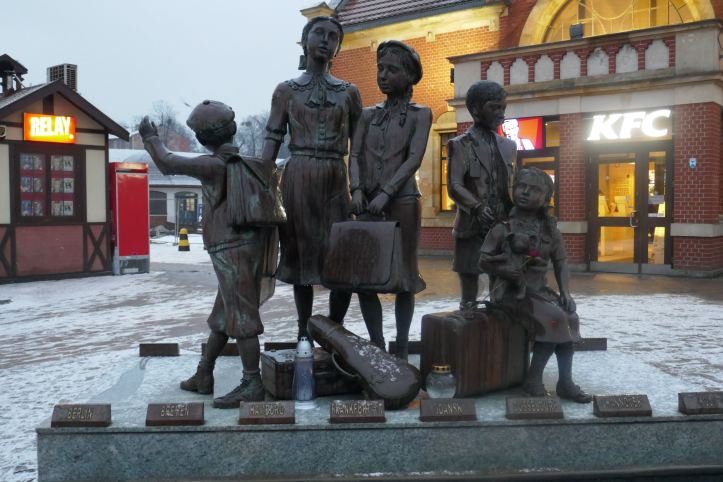
We buy tickets at the station to Gydnia, a thirty minute journey north, and board the ICC Inter-city train. It’s plush. Wide reclining seats, individual tables and spotlessly clean. As we pull away, it dawns on me that maybe we’re on the wrong train. A spot of Googling – after all, there’s free wi-fi on the train as well – proves me right. We’re on the 58 zloty train rather than the 3.20 zloty version!
In the absence of a ticket collector, we keep quiet and get off a Gydnia. We’re still in Pomerania and still in the Gdansk province. From being a farming and fishing village until the 20th century, it became a popular seaside resort and then opened its doors to the boating communities. During the war, it suffered badly and was rebuilt in a more modernistic style. Today, it is home to a naval academy and the yachting fraternity. It’s pretty quiet on a cold day in January and the three boats against the harbour wall that attract visitors are locked down for the winter.
The first, the ORP Błyskawica, is a Grom-class destroyer, one of the fastest and most heavily-armed of its type ever built by J. Samuel White in Cowes, on the Isle of Wight. The Błyskawica served in the Norwegian campaign, supported Operation Dynamo, recovering British troops from Dunkirk and in the Mediterranean, on convoy duties against U-boat and Luftwaffe attacks.
Alongside, is the Dar Pomorza, a Polish full-rigged sailing ship, built in 1909 and now serving as a training vessel attached to the naval academy. It’s huge and very much an ‘Onedin Line’ ship. Just standing by the gangway is enough to inspire a rendition of ‘Eh, James, tha’s come home to me from th’sea!”
I always fail to secure the manly parts in our house.
Finally, there’s the Dragon. It’s something of a folly. Jet black and gold, it’s a pirate ship in full rigging that now offers tourists short cruises during the summers and doubles up as a restaurant and bar. It’s fabulous and would certainly be no embarrassment if it berthed alongside the Black Pearl.
The wind coming off the Baltic Sea and rattling down Kosenszki Square, makes it an easy decision to move on. We head a short fifteen minute train ride south to Sopot. This time, we board the right train. No more ‘Orient Express’ for us…….this is rather more ‘Arriva’, I’m afraid. Still, it’s warm and doesn’t smell. The windows could do with a clean but it’s fine.
Sopot is a jewel. It’s part of what is referred to as the ‘Polish Riviera’. A classy ‘watering-hole’ for the rich, the train drops you at the top end of Bohaterów Monte Cassino, a wide street of elegant shops. It commemorates one of the proudest achievements in modern Polish military history. In 1943 the Allies, after a successful invasion of Sicily, moved to the continent. It seemed nothing could stop them until they approached a mountain range on the way to Rome. The area was occupied by the Germans defending what was called the Gustav Line, at the heart of which lay Monte Cassino. The battle that followed was actually a series of four intense battles which took place between January 20th and May 18th, 1944, culminating at a 1,300-year-old Benedictine monastery on the top of the 1,100 metre Monte Cassino. Involving British, US, Indian, French, North African, New Zealand, Gurkha and Polish troops, fierce fighting raged against the Germans on a slow and brutal advance towards the monastery. At a cost of over 25,000 lives the final battle ended on the morning of May 18th when a reconnaissance group of soldiers from the Polish 12th Podolian Uhlans Regiment finally fought their way through to the completely devastated monastery. The Battle of Monte Cassino was won, the Gustav Line broken and the Allied advance on Rome continued.
At the lower end of the street, the town meets the sea. From the top of the 132 steps of the Sopot lighthouse, the view takes in the wide promenade and the fine hotels, the finest being the Grand Hotel. Built in 1924, it has welcomed Alfonso XIII of Spain as well as other more infamous guests such as Martin Bormann, Goering, Hitler. Leni Riefenstahl, Castro and Putin. To ‘balance the books’, in fairness, it’s also welcomed Marlene Dietrich, Charles Aznavour, Greta Garbo, Annie Lennox, Demis Roussos, Omar Sharif and Boney M. We’d just missed Andrea Bocelli, apparently. You’d have thought that a room at the Grand would have been prohibitively expensive, but a quick check on Booking.com reveals that a room with a park view, perfectly acceptable, is £80 a night and ‘superior’ room for the night, one that looks seawards, come in at a little over £100. Now, that’s a bargain.
The sand is frozen and covered with a fine layer of snow. We walk out along the pier – 511 metres and the longest wooden pier in Europe. Now, I know that there will be those of you who will dispute this and tell me that Southend pier is 2158 metres, but the latter is made of iron as well as timber.
On the way back, we stop off at Cafe Joseph K in Gdansk. It’s a quirky place and feels like you’re stepping back in time. It’s named after Kafka’s eponymous hero and the bar is decorated accordingly. It’s rather odd that Kafka, a German-speaking Bohemian Jew, has a cafe named after him, but little recognition is given to Gunter Grass, who was born in Gdansk.
In fact, Grass was born in the suburb of Gdansk Wrzeszcz, where his father was a German grocer. Like many Germans, they made the decision to leave when Gunter was young and his military career was in the Waffen-SS before being taken prisoner by the US forces in 1945. He returned to Gdansk to work as an artist and writer until his death in 2015. There is a monument to Oskar Matzerath (The Tin Drum) in Gdansk Wrzeszcz and tributes were paid at Grass’s funeral by Lech Wałęsa and Pawel Adamowicz.

Day 4 – Friday
Today is a day to see how the people of Gdansk shop. We retrace our steps to Wrzeszcz where the Galeria Bałtycka houses over 200 shops in the beautiful of buildings. Shopping is ‘high-end’ here, spread over three floors and many independent outlets as well as the more familiar European names.
There are three main shopping complexes in the city. The Bałtycka is by far the best, but the Forum in the city centre comes a close second. Lastly, there is the Galerie Madison, but it comes a poor third.
We head back to the waterfront and cross the river Motlwa to where it joins the Vistula at the Restauicja Bazar. The restaurant is busy serving the Polish delicacies that you can enjoy across Gdansk : chicken, duck, wild boar, pork knuckle. There is always lots of cabbage on offer – stewed, fried or baked. However, wherever you go, the food is always presented attractively and with finesse. If you want ‘pile it high’ then go to the bar mleczny, the Polish ‘milk bars’, cafeteria where you can pick up a huge plate of bubbling goulash, stacked high with schnitzel for next to nothing.
Day 5 – Saturday
Yes, I know. This is a four day trip to Gdansk. However, we have an evening flight and two very heavy backpacks. Last days can be a misery if you have to take everything with you. However, I’ve discovered a solution. If you’re ever in the same position, try BagBNB.It operates in over 100 countries, worldwide. Simply book it on the web and they send you an email voucher. Our bag drop was at the Main Station Hostel, right next to the railway and bus stations. For €5 per person, per day, your bags are locked away while you’re enjoying the final day. It’s secure, cheap and convenient.
Finding a creche for our bags means that we can enjoy a final day in Gdansk. It gives us the chance to climb the 435 steps of the tower at St. Mary’s Basilica for a superb view out over the city.
Finally, we stop at the Gdansk Shakespeare Theatre. It’s an anthracite-black brick structure built on the site of the 17th century Fencing School. English travelling players first performed here as early as 1601. They would winter in Konigsburg and Warsaw before arriving in Gdansk for St. Dominic’s Fair in the first week of August. Nowadays, there is an annual Shakespeare Festival held during the same week followed by British Week, featuring British touring companies. It’s certainly not a pretty theatre, but it’s interesting. Inside, they’ve built a replica of the Globe, complete with area for Groundlings.
It’s time to catch a plane. I’ll be sorry to leave. I love Poland. We’ve visited Krakow, Warsaw, Wroclaw and now Gdansk. Each is different in its own way. Each has so much to offer. Where next? Katowice? Poznan? Who knows……

